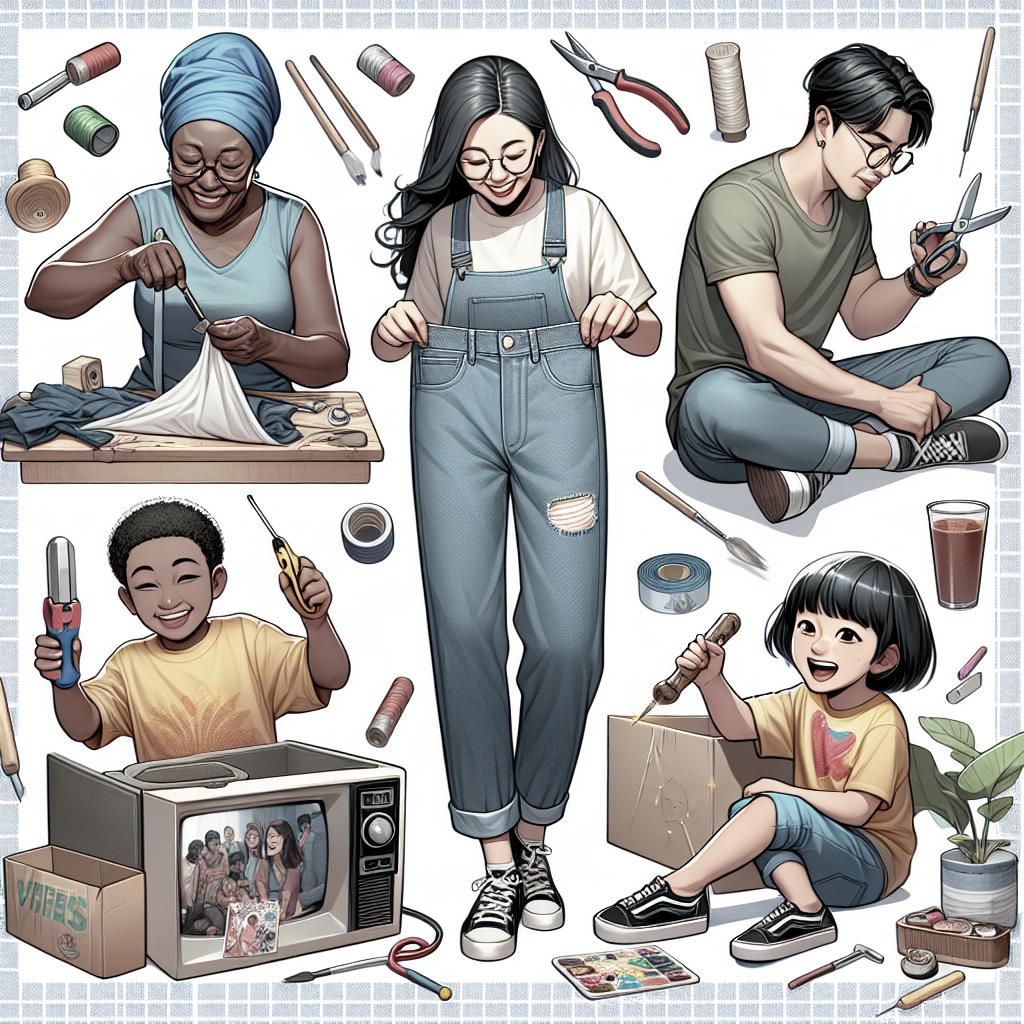“`html
How to Repurpose Old Clothes into Fashion-Forward Pieces
Revamping your wardrobe can be both economical and environmentally friendly. Instead of discarding unloved clothes, give them new life by transforming them into fashion-forward pieces. In this guide, we’ll explore various ways to creatively recycle your garments. From DIY dyeing techniques to adding unique embellishments, this make-over guide will challenge your creative instincts. Whether you’re looking to tailor for a better fit or turn fabric scraps into accessories, the possibilities are endless. This transformation journey not only saves money but contributes positively to sustainable fashion practices, allowing you to express individual style with a personalized touch.
DIY Dyeing
Dyeing is one of the simplest ways to breathe new life into old clothes. With the wide variety of fabric dyes available, you can experiment with different colors to match current trends or personal preferences. Consider using eco-friendly dyes which are safer for the environment and your health. Techniques such as tie-dye, ombre, or dip-dyeing add fun patterns and depth to bland clothing.
Start by choosing the right dye for your fabric type. Natural fibers like cotton and wool absorb colors well, while synthetic materials may require special dyes. Before dyeing, make sure to thoroughly wash your garment to remove oils and impurities. Follow the instructions on your chosen dye package for the best results. Whether you’re going for subtle earth tones or bright neon hues, dyeing can completely change the look and feel of a garment, giving it a vibrant new presence in your closet.
Add Embellishments
Adding embellishments is a surefire way to turn simple clothes into stunning masterpieces. Options like beads, sequins, and patches can elevate the aesthetic appeal of any piece of clothing. Explore adding embellishments to collars, cuffs, or hems to draw attention to specific parts of a garment.
Embellishing requires simple tools like needles, thread, and sometimes fabric glue, offering both sew-on and no-sew options for convenience. Patches provide a playful twist, allowing personal statements or symbols to decorate items like jackets or jeans. This creative process not only makes your clothes standout but also provides you with an opportunity to customize clothing pieces with personal memories or symbols that hold significance.
Repurpose and Redesign
Repurposing old clothes into entirely new garments is both a challenge and a rewarding project. Think creatively about how shirts can turn into dresses, jeans into skirts, or even multiple garments combined into one revamped piece. Pinterest and YouTube offer a treasure trove of redesign ideas that can spark inspiration.
Assess each item in your wardrobe for its potential and materials. Old sweaters can turn into cozy scarves or mittens, while shirts transform into chic totes or pillow covers. The goal is to see the value and possibility in items that may initially appear outdated or worn. This approach not only extends the life of your clothes but ensures no two pieces are exactly alike, promoting a unique style.
Mix and Match Fabrics
Mixing and matching fabrics involves combining different textures and patterns, creating clothes that are rich in contrast and character. You don’t need to be a professional seamstress to achieve this; basic sewing skills are sufficient to start combining fabrics.
Choose fabric scraps or remnants that complement one another, whether through color palettes or contrasting textures such as denim with silk or cotton with lace. Sew them together to refresh an item, such as adding new sleeves, creating patchwork designs, or installing unique pocket details. The harmony or juxtaposition of different textiles can transform basic garments into artful fashion statements.
Make Accessories
Fabric scraps and old garments provide excellent material for creating unique accessories. Items like scarves, headbands, and fabric jewelry are popular options to make the most out of fabric remnants. T-shirt yarn bracelets or brooches from embellished fabrics can refresh your accessory game.
The creation process is flexible; you can either embellish these items further or keep them simple based on personal style. Additionally, creating handmade accessories offers great potential for gifting, injecting a personal touch tailored to the recipients’ tastes. Crafting accessories is an enjoyable way to master upcycling skills and produce delightful designs.
Update with Paint or Stencils
Painting or stenciling designs onto fabric is a wonderful use of art to rejuvenate old clothes. Fabric paints and markers bring colors that withstand washing, allowing ample opportunities for customization from bold designs to intricate artworks.
Stencil usage is a foolproof method for those unconfident in freehand painting. Purchase or create stencils to achieve consistent, professional-looking designs across multiple clothing items. Paint projects can transform basic t-shirts, jeans, or jackets into truly one-of-a-kind garments, allowing your artistic spirit to shine while showcasing a unique personal brand.
Tailor for a Better Fit
Sometimes, clothing simply needs a better fit to become a wardrobe favorite once again. Tailoring old clothes can adjust them to better suit your current shape or style preference. Whether it means taking in seams, moving buttons, or shortening lengths, little adjustments can make a huge difference.
Familiarize yourself with basic sewing techniques or consider hiring a tailor for more complex alterations. A well-fitting piece makes you feel confident and comfortable, breathing new life into what might have been forgotten items. This approach helps reduce waste by turning discards into staple wardrobe pieces.
Layer and Combine
Layering and combining clothing offers versatile options as fashion staples. To achieve this, pair old pieces with newer ones or layer them to suit both seasonal changes and personal taste. Mixing and matching can exert boldness or subtlety, based on your chosen combinations.
Consider layering thinner tops under dresses, structuring oversized garments with belts, or experimenting with different lengths to create visually appealing dimensions. The key is to redefine how items interact in your wardrobe, taking advantage of the depth and versatility layers provide, while emphasizing style creativity and adaptability.
Summary of Main Points
| Technique | Details |
|---|---|
| DIY Dyeing | Experiment with colors using eco-friendly dyes and techniques like tie-dye to revitalize fabrics. |
| Add Embellishments | Enhance clothing aesthetics with beads and patches, offering custom touches to collars and hems. |
| Repurpose and Redesign | Transform garments creatively to give them new purposes, such as turning shirts into dresses. |
| Mix and Match Fabrics | Combine textures and patterns to create harmony or contrast, turning clothes into artistic statements. |
| Make Accessories | Utilize fabric scraps to create personal accessories like headbands and fabric jewelry. |
| Update with Paint or Stencils | Use fabric paints and stencils to add artistic designs, converting plain garments into unique pieces. |
| Tailor for a Better Fit | Adjust clothing for improved fit and style, extending their life and increasing wearability. |
| Layer and Combine | Explore layering old and new pieces to highlight creativity and versatility in your wardrobe. |
“`


